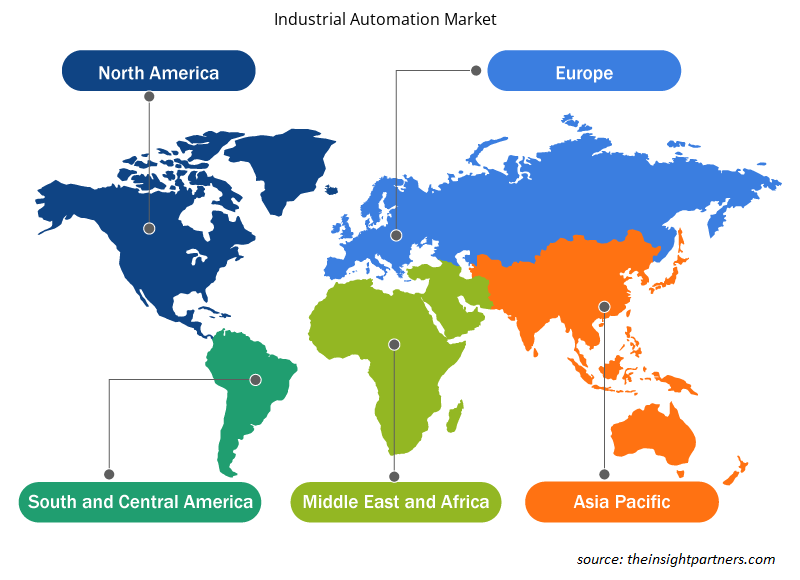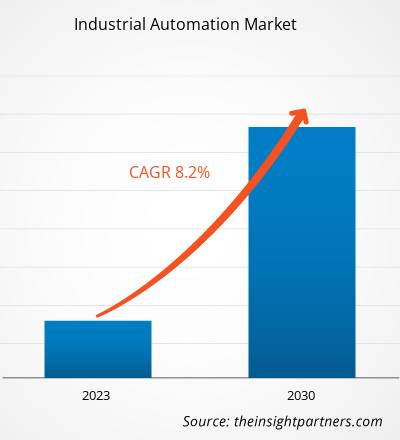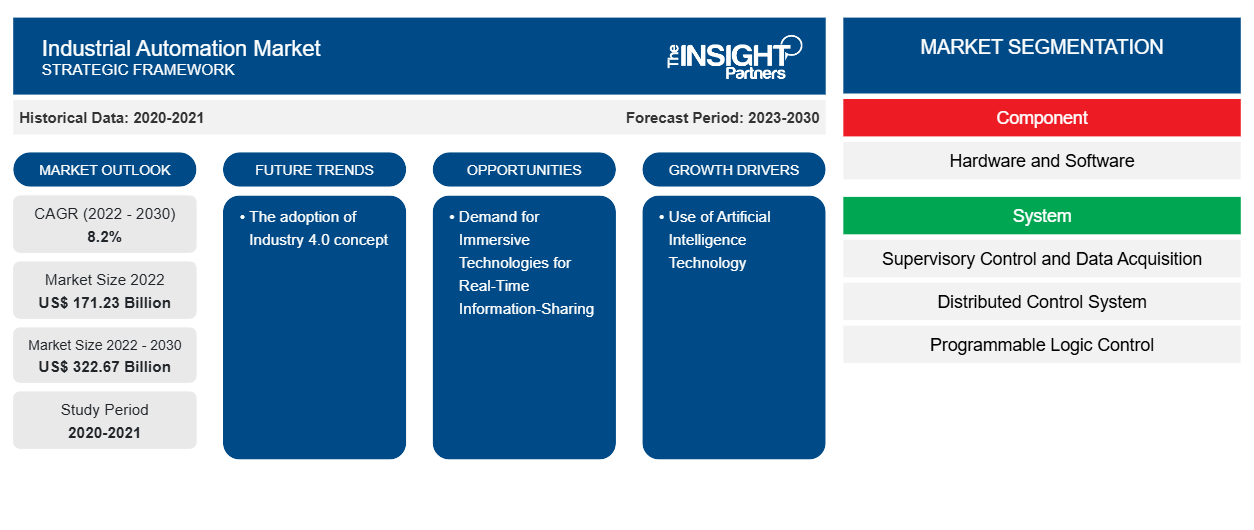Der Markt für industrielle Automatisierung wird voraussichtlich von 171,23 Milliarden US-Dollar im Jahr 2022 auf 322,67 Milliarden US-Dollar im Jahr 2030 anwachsen. Der Markt wird zwischen 2022 und 2030 voraussichtlich eine durchschnittliche jährliche Wachstumsrate (CAGR) von 8,2 % verzeichnen. Die Einführung des Konzepts Industrie 4.0 dürfte ein wichtiger Trend auf dem Markt bleiben.CAGR of 8.2% during 2022–2030. The
Marktanalyse für industrielle Automatisierung
Der Einsatz künstlicher Intelligenz, neu entstehende vernetzte Unternehmen und der Fokus auf betriebliche Effizienz treiben den Markt an. Aufgrund der positiven Initiativen der Regierung zur Förderung der industriellen Automatisierung wird für den Prognosezeitraum ein Marktwachstum erwartet. Darüber hinaus schaffen die Nachfrage nach immersiven Technologien für den Informationsaustausch in Echtzeit und die Integration von Bildverarbeitungssystemen mit Deep-Learning-Technologien lukrative Möglichkeiten für den Markt.
Marktübersicht für industrielle Automatisierung
Die industrielle Automatisierung ersetzt menschliche Eingriffe durch den Einsatz von Steuerungssystemen wie Robotern, Computern und Informationstechnologie zum Betrieb verschiedener Maschinen in einer Industrie. Abhängig von den beteiligten Vorgängen werden Steuerungssysteme für die industrielle Automatisierung in zwei Kategorien unterteilt: Prozessanlagenautomatisierung und Fertigungsautomatisierung. Die industrielle Automatisierung verbessert die Produktqualität, Zuverlässigkeit und Produktionsrate und senkt gleichzeitig die Herstellungs- und Konstruktionskosten durch den Einsatz neuer, innovativer und integrierter Technologien und Dienste. Sie verfügen über eine Reihe von Eigenschaften, darunter hohe Produktivität, Qualität, Flexibilität und Informationskorrektheit, die den Einsatz der Automatisierung im Industriesektor im Prognosezeitraum voraussichtlich fördern werden. Darüber hinaus treibt der Anstieg der Einführung von Automatisierungslösungen in den Branchen Öl und Gas, Fertigung, Chemie und Materialien, Pharmazeutik und anderen Branchen die industrielle Automatisierung voran.
Passen Sie diesen Bericht Ihren Anforderungen an
Sie erhalten kostenlos individuelle Anpassungen an jedem Bericht, einschließlich Teilen dieses Berichts oder einer Analyse auf Länderebene, eines Excel-Datenpakets sowie tolle Angebote und Rabatte für Start-ups und Universitäten.
-
Holen Sie sich die wichtigsten Markttrends aus diesem Bericht.Dieses KOSTENLOSE Beispiel umfasst eine Datenanalyse von Markttrends bis hin zu Schätzungen und Prognosen.
Treiber und Chancen auf dem Markt für industrielle Automatisierung
Einsatz künstlicher Intelligenz zur Förderung des Marktes
Künstliche Intelligenz (KI) verändert die Fertigung auf unglaubliche Weise. KI ermöglicht es Maschinen, zu lernen, sich anzupassen und autonom Entscheidungen zu treffen. Hersteller nutzen die Technologie, um Muster und Anomalien bei Anlagen aufzudecken, um die Produktion zu optimieren und Ausfallzeiten zu vermeiden. Beispielsweise verbessert die Integration von KI in Industrieroboter und Drohnen die Präzision und hilft bei Aktivitäten wie Inspektion, Wartung und Materialhandhabung. Dies verringert den Bedarf an menschlichem Eingreifen, verringert die Unfallgefahr, erhöht die Wartungseffizienz und verlängert die Lebensdauer der Geräte. Darüber hinaus verwenden Betriebstechnikingenieure (OT), die mit Abläufen und Geräten vertraut sind, zunehmend ausgefeilte KI-Technologien mit visuellen Point-and-Click-Benutzeroberflächen (UI). Die Verfügbarkeit vorgefertigter Apps für maschinelles Lernen (ML) und die industrielle Nachfrage nach Automatisierung beflügeln den Markt.prebuilt machine learning (ML) apps and industrial demand for automation is fueling the market.
Nachfrage nach immersiven Technologien für den Informationsaustausch in Echtzeit
Virtual Reality (VR) und Augmented Reality (AR) sind immersive Technologien, die den Informationsaustausch in Echtzeit ermöglichen, um die Schulung von Mitarbeitern zu unterstützen, menschliche Fehler zu vermeiden und die Leistung zu steigern. Das bedeutet, dass VR und AR einen erheblichen kommerziellen Mehrwert bieten können, indem sie die Sicherheit der Mitarbeiter verbessern, die Produktivität steigern und Ausfallzeiten reduzieren. AR kann Industrieunternehmen helfen, indem sie Maßnahmen zur Wiedereingliederung in den Beruf erleichtert, wie z. B. Remote-Zusammenarbeit, Remote-Unterstützung, erweiterte Arbeitsanweisungen und 3D-Schulungen. AR unterstützt auch bei längerfristigen Strategien für die Zukunft der Arbeit, die darauf abzielen, die Qualifikationslücke zu schließen und erhebliche Gewinne zu erzielen. Augmented Reality wird am Arbeitsplatz immer wichtiger.VR) and augmented reality (AR) are immersive technologies that enable real-time information sharing to aid worker training, eliminate human errors, and boost performance. That implies VR and AR may add significant commercial value by improving worker safety, increasing productivity, and reducing downtime.
- Streamen Sie Daten aus dem industriellen Internet der Dinge (IIoT) und von Sensoren, um die Zustandsüberwachung, Fehlerbehebung und Reparaturen zu verbessern.IIoT) and sensor data to improve condition monitoring, troubleshooting, and repairs.
- Sehen Sie sich umfassende 3D-Arbeitsanweisungen für Montage-, Inspektions- und Wartungsverfahren an.
- Erhalten Sie eine Schritt-für-Schritt-Anleitung und bedarfsgerechte Unterstützung von erfahrenen Fachleuten.
- Geben Sie Kommentare zu den Umständen, die Sie in der Fabrik oder vor Ort beobachten, an den verbundenen digitalen Thread zurück und ermöglichen Sie so ein Closed-Loop-Feedback im gesamten Unternehmen.
Bediener und Servicetechniker nutzen anspruchsvolle Augmented Reality, um Betriebsabläufe zu optimieren.
Segmentierungsanalyse des Marktberichts zur industriellen Automatisierung
Wichtige Segmente, die zur Ableitung der Marktanalyse für industrielle Automatisierung beigetragen haben , sind Komponente, System und Endbenutzer.
- Basierend auf den Komponenten ist der Markt für industrielle Automatisierung in Hardware und Software unterteilt. Das Hardwaresegment hatte im Jahr 2022 einen größeren Marktanteil.
- Nach System ist der Markt in Überwachungssteuerung und Datenerfassung, verteilte Steuerungssysteme, speicherprogrammierbare Steuerung und andere segmentiert. Das Segment Überwachungssteuerung und Datenerfassung dürfte im Prognosezeitraum expandieren.
- Basierend auf den Endverbrauchern ist der Markt in Öl und Gas, Automobil, Lebensmittel und Getränke, Chemie und Materialien, Luft- und Raumfahrt und Verteidigung und andere unterteilt. Das Öl- und Gassegment hatte im Jahr 2022 einen größeren Marktanteil.
Marktanteilsanalyse für die industrielle Automatisierung nach geografischen Gesichtspunkten
Der geografische Umfang des Marktberichts zur industriellen Automatisierung ist hauptsächlich in fünf Regionen unterteilt: Nordamerika, Asien-Pazifik, Europa, Naher Osten und Afrika sowie Süd- und Mittelamerika.
Der Markt im asiatisch-pazifischen Raum dürfte im Prognosezeitraum aufgrund der Präsenz wichtiger Akteure wachsen. Omron Corporation, Mitsubishi Electric Corporation, Hitachi Ltd. und andere bieten ihren Kunden technologisch fortschrittliche Fabrikautomatisierungsprodukte an, die ihre Betriebseffizienz verbessern. Wachsende Branchen und die zunehmende Einführung industrieller Automatisierungstechnologien beflügeln den Markt.
Regionale Einblicke in den Markt für industrielle Automatisierung
Die regionalen Trends und Faktoren, die den Markt für industrielle Automatisierung im Prognosezeitraum beeinflussen, wurden von den Analysten von Insight Partners ausführlich erläutert. In diesem Abschnitt werden auch die Marktsegmente und die Geografie des Marktes für industrielle Automatisierung in Nordamerika, Europa, im asiatisch-pazifischen Raum, im Nahen Osten und Afrika sowie in Süd- und Mittelamerika erörtert.

- Erhalten Sie regionalspezifische Daten zum Markt für industrielle Automatisierung
Umfang des Marktberichts zur industriellen Automatisierung
| Berichtsattribut | Details |
|---|---|
| Marktgröße im Jahr 2022 | 171,23 Milliarden US-Dollar |
| Marktgröße bis 2030 | 322,67 Milliarden US-Dollar |
| Globale CAGR (2022 - 2030) | 8,2 % |
| Historische Daten | 2020-2021 |
| Prognosezeitraum | 2023–2030 |
| Abgedeckte Segmente |
Nach Komponente
|
| Abgedeckte Regionen und Länder |
Nordamerika
|
| Marktführer und wichtige Unternehmensprofile |
|
Marktteilnehmerdichte: Der Einfluss auf die Geschäftsdynamik
Der Markt für industrielle Automatisierung wächst rasant. Dies wird durch die steigende Nachfrage der Endnutzer aufgrund von Faktoren wie sich entwickelnden Verbraucherpräferenzen, technologischen Fortschritten und einem größeren Bewusstsein für die Vorteile des Produkts vorangetrieben. Mit der steigenden Nachfrage erweitern Unternehmen ihr Angebot, entwickeln Innovationen, um die Bedürfnisse der Verbraucher zu erfüllen, und nutzen neue Trends, was das Marktwachstum weiter ankurbelt.
Die Marktteilnehmerdichte bezieht sich auf die Verteilung von Firmen oder Unternehmen, die in einem bestimmten Markt oder einer bestimmten Branche tätig sind. Sie gibt an, wie viele Wettbewerber (Marktteilnehmer) in einem bestimmten Marktraum im Verhältnis zu seiner Größe oder seinem gesamten Marktwert präsent sind.
Die wichtigsten auf dem Markt für industrielle Automatisierung tätigen Unternehmen sind:
- ABB Ltd.
- Bosch Rexroth AG
- Emerson Electric Co.
- Hitachi Ltd.
- Honeywell International, Inc.
- Mitsubishi Electric Corporation
Haftungsausschluss : Die oben aufgeführten Unternehmen sind nicht in einer bestimmten Reihenfolge aufgeführt.

- Überblick über die wichtigsten Akteure auf dem Markt für industrielle Automatisierung
Neuigkeiten und aktuelle Entwicklungen zum Markt für industrielle Automatisierung
Der Markt für industrielle Automatisierung wird durch die Erhebung qualitativer und quantitativer Daten nach Primär- und Sekundärforschung bewertet, die wichtige Unternehmensveröffentlichungen, Verbandsdaten und Datenbanken umfasst. Nachfolgend sind einige der Entwicklungen auf dem Markt für industrielle Automatisierung aufgeführt:
- Im Jahr 2023 markierte die Übernahme von National Instruments durch Emerson Electric für 8,2 Milliarden US-Dollar im April 2023 einen strategischen Schritt zur Stärkung seiner Präsenz in der industriellen Automatisierung. Der Deal stand im Einklang mit Emersons Streben nach Wachstum im Bereich Test und Messung und nutzte die softwaregesteuerten automatisierten Systeme von National Instruments, um eine verbesserte Rentabilität und Branchendiversifizierung zu erzielen. Dieser Schritt spiegelte den Anstieg der Nachfrage nach fortschrittlichen Automatisierungslösungen wider. (Quelle: Emerson Electric Co., Unternehmenswebsite, Oktober 2023)
- ABB India sicherte sich einen bedeutenden Auftrag für die Elektrifizierung und Automatisierung des modernen Kaltwalzwerks von ArcelorMittal Nippon Steel India in Hazira. Die Technologie von ABB zielte darauf ab, die Energieeffizienz, die Optimierung des Zinkverbrauchs und die Korrosionsbeständigkeit zu verbessern und steht damit im Einklang mit den Nachhaltigkeitszielen von AM/NS India. Diese Zusammenarbeit zeigte das transformative Potenzial der industriellen Automatisierung. (Quelle: ABB Ltd, Unternehmenswebsite, Juni 2023)
Marktbericht zur industriellen Automatisierung – Umfang und Ergebnisse
Der Bericht „Marktgröße und Prognose für die industrielle Automatisierung (2020–2030)“ bietet eine detaillierte Analyse des Marktes, die die folgenden Bereiche abdeckt:
- Größe und Prognose des Marktes für industrielle Automatisierung auf globaler, regionaler und Länderebene für alle wichtigen Marktsegmente, die im Rahmen des Berichts abgedeckt sind
- Markttrends und Marktdynamiken im Bereich der industriellen Automatisierung wie Treiber, Einschränkungen und wichtige Chancen
- Detaillierte PEST/Porters Five Forces- und SWOT-Analyse
- Analyse des Marktes für industrielle Automatisierung, die wichtige Markttrends, globale und regionale Rahmenbedingungen, wichtige Akteure, Vorschriften und aktuelle Marktentwicklungen umfasst
- Branchenlandschaft und Wettbewerbsanalyse, einschließlich Marktkonzentration, Heatmap-Analyse, prominenten Akteuren und aktuellen Entwicklungen auf dem Markt für industrielle Automatisierung
- Detaillierte Firmenprofile
- Historische Analyse (2 Jahre), Basisjahr, Prognose (7 Jahre) mit CAGR
- PEST- und SWOT-Analyse
- Marktgröße Wert/Volumen – Global, Regional, Land
- Branchen- und Wettbewerbslandschaft
- Excel-Datensatz
Aktuelle Berichte
Erfahrungsberichte
Grund zum Kauf
- Fundierte Entscheidungsfindung
- Marktdynamik verstehen
- Wettbewerbsanalyse
- Kundeneinblicke
- Marktprognosen
- Risikominimierung
- Strategische Planung
- Investitionsbegründung
- Identifizierung neuer Märkte
- Verbesserung von Marketingstrategien
- Steigerung der Betriebseffizienz
- Anpassung an regulatorische Trends























 Kostenlose Probe anfordern für - Markt für industrielle Automatisierung
Kostenlose Probe anfordern für - Markt für industrielle Automatisierung